The two-island nation of Trinidad and Tobago in the Caribbean (just off the coast of Venezuela) may be smaller than Delaware, but it has had an outsized role in the history of rainforest conservation as well as our understanding of tropical ecology. Home to an astounding number of tropical ecosystems and over 3,000 species and counting (including 470 bird species in just 2,000 square miles), Trinidad and Tobago is an often overlooked gem in the world’s biodiversity.
“In the last 100 years, work in these forests was instrumental in deciphering principles we now take for granted. For example: echolocation in bats, animal chemical defenses and mimicry,” Nigel Noriega, the director of Sustainable Innovation Initiatives (SSI) told mongabay.com adding that the “Tobago Main Ridge Forest Reserve is under consideration as a UNESCO World Heritage Site because it is on record as the world’s oldest legally protected forest reserve geared specifically towards a conservation purpose. It was recognized as early as 1776 that the forests were crucial to maintaining the rainfall on these islands.”
A part of the reason for the island’s impressive biodiversity (including 85 endemic species so far) is that Trinidad and Tobago are islands that act as evolutionary laboratories, but still containing heavy influences from the South American mainland to which the islands were likely connected in the recent past.
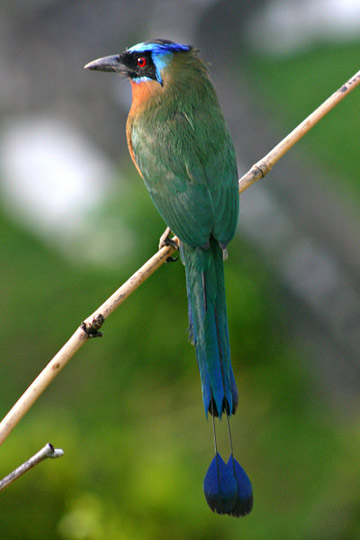
“[Trinidad and Tobago]’s swirling stew of biogeography takes on characteristics of a giant ecotone (ecotones are transition zones between ecosystems). Each of its habitat is large enough to be legitimate, but small enough to be a buffer zone in the more massive mainland systems. Blending and adaptation are being observed at closer ranges and higher speeds than we might be accustomed to thinking about,” Noriega says.
This is no-where better observed than in the guppies of Trinidad, which have become the focal point of numerous studies across multiple disciplines. The guppy populations on this small island are unlocked new visions of how species evolve, according to Noriega.
“It is the first time we have had such a detailed look at evolution in the very first stages of population adaptation. Such a new perspective is exposing a lot of details we previously did not know we needed to examine, or were simply unable to measure. Guppy studies in Trinidad have created a conceptual toolbox that is compelling us to explore hypotheses that were not previously imagined. The impact on science is tremendous!”
However like most of the world’s tropical forests, those of Trinidad and Tobago are imperiled by human actions.
“I think the overarching threat is value-assignment. There is a culture of devaluing the biodiversity of the tropics even while it is used to fuel the commerce of the rest of the world,” Noreiga says, adding that “the history of the Caribbean has been based on trading our valuables for global commerce and people here are still trained on the most basic levels to think of this pattern as beneficial. I think this type of culture is the root of many major threats.”
Noriega’s year-old NGO, Sustainable Innovation Initiatives, is working to educate people in Trinidad about the importance of biodiversity through a number of initiatives including film production, field sites for researchers, and getting science from researchers to the public.
AN INTERVIEW WITH NIGEL NORIEGA
Mongabay: Will you tell us about Trinidad and Tobago’s forests?
Nigel Noriega: There is quite a bit of history here. In the last 100 years, work in these forests was instrumental in deciphering principles we now take for granted. For example: echolocation in bats, animal chemical defenses and mimicry. William Beebe, America’s most famous naturalist before the age of television, invested a lot of effort in these forests and spent his final years here. Even before the age of ecotourism, forests here have been world famous for the large number of bird species that are accessible in a short time.
The Tobago Main Ridge Forest Reserve is under consideration as a UNESCO World Heritage Site because it is on record as the world’s oldest legally protected forest reserve geared specifically towards a conservation purpose. It was recognized as early as 1776 that the forests were crucial to maintaining the rainfall on these islands.
Forests in Trinidad and Tobago (T&T) are diverse for such a small area. They include cloud, dry deciduous and semi-evergreen variations. About 12% of the original primary forest is left. However, between 40-45% of the land area has some sort of tree cover, including secondary forests which have re-colonized former plantations and areas used for other agriculture.
Mongabay: These small islands have over 3,000 known species. Why are they so biodiverse?
Nigel Noriega: Your question is being investigated on many levels. Some of T&T biodiversity is explained by geological history. Trinidad and Tobago were formerly connected to mainland South America. Trinidad’s Northern Range is an extension of the Coastal Cordillera range in Venezuela. Offshore in the continental shelf, there is geological evidence of rivers that formerly connected what is now Trinidad with other parts of South America when sea levels were lower. This physical evidence combined with genetic data from Trinidad’s guppies suggests Trinidad’s freshwater river systems could have extended into Venezuela and Guyana during the last ice age. So, pending investigation, part of your explanation may be found in ancient waterways that were biological corridors. In addition, the outflow from of the Orinoco delta sends South American vegetation, seeds, microbes and stowaway animals that have been settling in Trinidad with a certain periodicity over the centuries.
Habitat diversity may be another answer to your question. Hillside and lowland forest, full-fledged natural savannah, swamp, mangrove, coupled with sedimentary, metamorphic, volcanic and limestone substrate are all packed into less than 2000 square miles on two islands only 11 degrees from the equator… It’s a pretty good formula for biodiversity, and I’m not even getting into the marine ecosystems. Surrounding the islands, reefs are connected to super-deep offshore areas, and huge volumes of freshwater, sediment and nutrient outflow from one of the longest rivers in South America (the Orinoco).
If you want to add unique microbes to your species list, there is potential for endemics in the “extremophile” environments like mud volcanoes. Trinidad essentially lies at the intersection of two major tectonic plates whose interaction has generated one of the largest natural asphalt deposits in the world bubbling up at its southwest end. This type of environment could be a hot-bed of unique microbial life.
There is a theoretical component to answering your question as well. T&T’s swirling stew of biogeography takes on characteristics of a giant ecotone (ecotones are transition zones between ecosystems). Each of its habitat is large enough to be legitimate, but small enough to be a buffer zone in the more massive mainland systems. Blending and adaptation are being observed at closer ranges and higher speeds than we might be accustomed to thinking about. In general, processes that accelerate evolution are enhanced through all that we normally associate with island-speciation phenomena, but processes thought to impede evolution are enhanced by proximity to gene pools on the mainland. Although these processes are working simultaneously, they do not simply cancel each other out. You might think of T&T like a “crossfit athlete of evolution” that has an “evolutionary metabolism” with high anabolic and catabolic components.
Mongabay: Will you tell us about some standout endemic species on the islands?
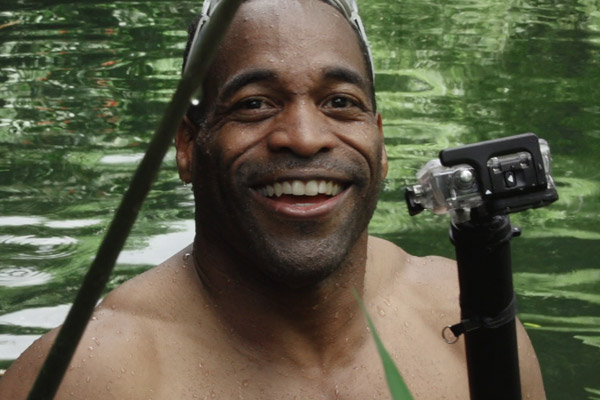
Nigel Noriega: Of the 3,000 or so species here, about 85 are endemic (i.e. found nowhere-else in the world). The list of T&T endemics is growing as people begin to look more closely. About 30 of these are vertebrates, insects, crustaceans and arachnids. The rest of list I’m referring to includes vascular plants. There are others who can tell you more about microbes, algae, fungi, lichens etc. that are not normally included in the counts.
Standout examples include the striking Trinidad motmot (Momotus bahamensis), found on both Trinidad and Tobago, and the Pawi or Trinidad piping guan (Pipile pipile), listed as Critically Endangered. Pawis belongs to an evolutionarily old group (Cracidae) that you might think of as precursors to the galliformes (i.e. the group that contains turkeys, chickens, quail etc.). Almost in the realm of folklore, is the cave-dwelling luminous lizard (Riama shrevei), a member of the genus Proctoporus that reflects light along each side of its back, and lives in caves to seek cooler temperatures than you normally find in the tropics. The El Tucuche golden tree frog (Phyllodytes auratus), considered Critically Endangered, has been a symbol of conservation efforts, and is found in cloud forests on two peaks at elevations above 800 meters. But there are other endemic frogs such as the colorful Bloody Bay fragrant frog (Mannophryne olmonae), listed as Vulnerable. The guppy has two close relatives that are endemic. There are also endemic armored catfishes, some of which have been marketed as “suckerfish” for aquariums. Among endemic snakes, the Trinidad worm snake (Typhlops trinitatus), is blind and burrows. Many of the invertebrates do not yet have common names. T&T’s longhorned beetle is the world’s only member of its genus. The endemic velvet worm catches insects like crickets and cockroaches, and is absolutely stunning to look at. The group of endemic spiders include two types of tarantulas. The list also includes high-elevation ants, a freshwater crab, a freshwater shrimp and scorpions. Endemic vascular plants include orchids, gymnosperms (non-flowering plants) and bromeliads.
If you consider possible human manipulation in the creation of endemics, the variety of cacao (cocoa) called Trinitario originated in Trinidad and appears to have been endemic for a small period before it was distributed throughout the global tropics to become the major source of high-grade chocolate.
Mongabay: What are the major threats facing the remaining forests on these two islands?
Nigel Noriega: I think the overarching threat is value-assignment. There is a culture of devaluing the biodiversity of the tropics even while it is used to fuel the commerce of the rest of the world. Small size is an issue. A single person in Trinidad or Tobago could make a decision that can affect huge percentages of ecosystem in a very short time… sometimes before anyone has a chance to notice.
Sand, gravel and mineral quarries are minimally regulated. Quarries are have deforested hillsides in key habitats, which has lead to runoff siltation that destroy streams and water supplies of rural people. Villagers asking for relief from the pollution and noise from dynamite and heavy machinery often seem to receive little response. Quarry companies have the means and legal requirement to reduce or remediate some of this damage. There are many opportunities to build better relationships here.
Forest fires have been deforesting large tracts of land, leading to the erosion that causes massive amounts of the landscape to end up being washed into the sea. In T&T, lightning strikes are not firestarters as they are in other climates. Fires here are started by hunters, agricultural practices, carelessness, and people burning garbage.
More insidious threats include contamination from industrial toxins and unregulated pesticide (particularly herbicide) use. Individual citizens can make huge contributions to reducing toxic waste, pesticide contamination and forest fires, but the threat to these individual contributions is cultural. The history of the Caribbean has been based on trading our valuables for global commerce and people here are still trained on the most basic levels to think of this pattern as beneficial. I think this type of culture is the root of many major threats.
Mongabay: What needs to be done to retain the islands rich biodiversity?
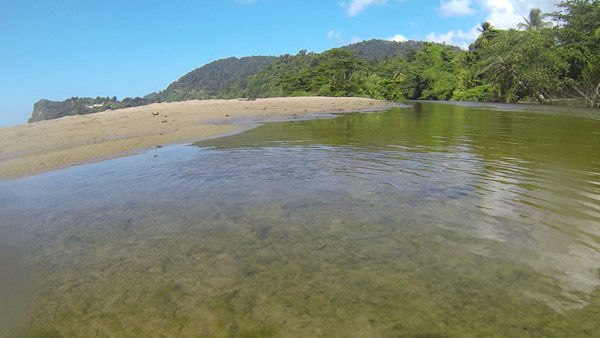
Nigel Noriega: Education is critical. Genetic information has been shaping world economies since the dawn of agriculture. We discover this information through interaction with the biodiversity of life. For example biochemical innovations are rarely conjured up in laboratories the way they are depicted in advertising or fiction. The majority of innovations come from observing and mimicking how physics and chemistry are manipulated in living systems. Much innovation comes from seeing how species use resources in ways we have not considered. If people understand the role of biodiversity in these equations, they can better evaluate information fed to them by the companies that monopolize agribusiness and biomedical science to dictate how so much land and water ends up being poorly used.
In T&T, I think moving toward the agroforestry of indigenous flora is a way to increase food-security, create market value, rebuild soil viability and build the biological corridors that can maintain biodiversity while improving both social and economic conditions. That seems like a big leap for a lot of people. However, citizens in communities like Fondes Amandes and Brasso Seco are already taking steps in this direction.
Allowing biodiversity to be recognized has part of our heritage and culture results in the pride and care that make citizens want to develop it as a sustainable resource that they can share with the world. We see that happening with citizens at our sea turtle nesting sites like Matura and Grand Riviere.
Incorporation of waste as a resource can limit the amount that ends up as environmental and public health hazards. Forest fires also need to be brought more under control. Again, communities like Fondes Amandes have made great strides in raising public awareness and we are seeing a change in attitudes over the decades. People often look to government first to address these issues, but action dependent on votes is very slow without citizen awareness. These initiatives have to come from citizenry first.
The harvesting of wild plants and animals for commerce and pet trades has a large impact on islands as small as these. We have seen phenomena like our scarlet macaws being hunted to extinction for the pet trade. Citizens also need to be aware of effects of the bushmeat trade. Again, moving to a more agroforesty-based food-economy can open new dimensions to the prospects of sustainable harvest and replenishment. For now, if people rely on bushmeat for sustenance, then citizens need to coordinate for means to support a sustainable harvest. The role of appropriate laws and enforcement is a work in progress where wildlife is concerned. Support for forestry and wildlife services can be helpful here.
Updates to biodiversity designation methods may help too. Internationally, “biodiversity hot spot” status is assigned using vascular plant survey criteria that inherently disfavor small islands without consideration for how critical islands are for the rapid generation of biodiversity. Although these criteria have been of tremendous organizational value, biodiversity is much more than numbers and lists. Islands almost always create unique evolutionary conditions. We have stunning easy-to-understand examples ranging from islands as small as the Galapagos to as large as Australia, but as we are learning from evolution studies in Trinidad, islands with more complex scenarios yield information that is just as valuable as ones that appear dramatically simple. But even if we did go by the “numbers and lists” criteria; there are few areas in the world that can house 470 species of birds in 2,000 square miles the way T&T does. The problem is that folks considering biodiversity lists are comparing T&T to areas hundreds of times its size on the mainland. But you would not expect the same bird diversity in an equivalent area on the mainland.
Mongabay: What is so remarkable about the guppies (Poecilia reticulata) of Trinidad?

Nigel Noriega: What is remarkable is the type of information gained from studying guppies in Trinidad’s ecosystems. The “Natural Laboratory” that Trinidad’s guppies occur in enables us to gather such information because no other study system like it exists to date. To understand this, it is important to understand the design of scientific experiments. Every variable tested must have controls, which are reference points used to increase the confidence with which you can draw conclusions. This is why experiments must be replicated many times to test each change in conditions.
An individual stream in Trinidad contains multiple habitats separated by barriers, which some fish can pass but others cannot. This allows multiple “natural experiments” to be observed in a single stream. Then consider that every few miles a similar set of experiments is replicated in another stream. This allows replication over whole sections of mountain. In addition, guppies in Trinidad exist in different populations that are derived from separate gene stocks. The western population has closest relatives in Venezuela, and the eastern population has closest relatives in Guyana. This genetic diversity adds another layer of comparison that one almost never finds in natural systems because populations generally mix over time.
The last factor is that although the guppy populations here are diverse, they have been separated within individual streams and isolated on the island for long periods of time. Therefore, when individuals do move to new habitats or populations, the data we can extract in Trinidad is very clean compared to what would be seen in mainland populations where the gene pool is mixed so constantly that it is difficult to calibrate. This type of scenario is what makes islands so good for unraveling difficult puzzles in evolution, and it is particularly pronounced in the case of Trinidadian guppies.
To be able to have this kind of controlled replication in a natural environment is something found nowhere else in the world at the moment. It accounts for a lot of what scientists call “black-box” variables, and allows them to link concepts in ways that laboratory studies alone cannot account for. Traditional laboratory studies can only take what we understand into account.
Another remarkable thing is that guppy data have forced us to entirely re-think the relative time scales that evolution and ecology operate on. The days of thinking of animals as “adapted to their environments,” may be numbered, due to the reorganization of theory resulting from guppy studies in Trinidad. These studies demonstrate the need to consider how animals alter their environments. Animals simultaneously adapt to sexual selection, investing in offspring as well as competing and cooperating with members of their own species. At the same time they are adapting to behaviors and environmental changes made by other species like their predators or prey or humans. The ability to examine wild guppies under the unique conditions presented in Trinidad is giving us tools to look at these adaptations both simultaneously and in real-time. It is the first time we have had such a detailed look at evolution in the very first stages of population adaptation. Such a new perspective is exposing a lot of details we previously did not know we needed to examine, or were simply unable to measure. Guppy studies in Trinidad have created a conceptual toolbox that is compelling us to explore hypotheses that were not previously imagined. The impact on science is tremendous!
Mongabay: Why are they such good subjects for study?
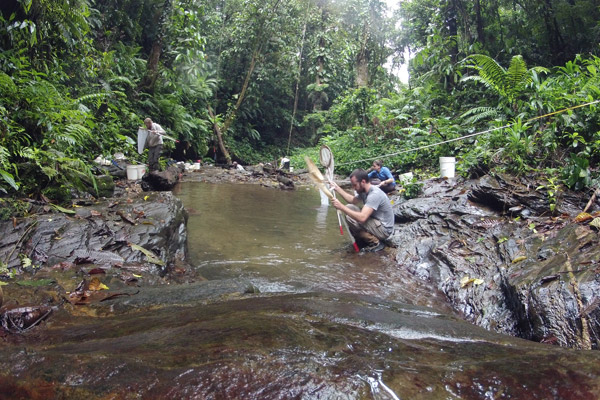
Nigel Noriega: Guppies are highly adaptable and breed under many conditions. This is what has made them such a popular aquarium fish. The popularity of guppies gives them a long history of being well-known with detailed observations and a lot of background data. This combination of characteristic helps species become used as scientific models.
A more unfortunate characteristic of “model species” is that to become well-well known, it often means that they are domesticated or genetically inbred strains. What makes guppies exceptional compared to other model organisms is that we can look well-known characteristics in completely wild animals. This gives scientists all the advantages but not the limitations of working with traditional model species. When ecosystem structure (replicated system controls) and multiple wild gene stocks (replicated genetic controls) are taken into account, guppies give three times the bang for the buck… so to speak.
This triple-value continues to rise exponentially because it now becomes very practical for scientists to share the same data across many fields of study that are traditionally different to bridge. For the first time, we can look at evolution and ecology of traits like behavior, mate selection, nerve physiology, cognition, and morphology all together in the same individuals. And we can do it in their natural habitat through many generations. Of course a lot of the work in wild guppies is combined with and cross-referenced with detailed laboratory studies that often involve the offspring sired by animals in the wild study population. Can you now see how many significant information layers can be packed into the study of a few populations of guppies?
Although there are precedents for this kind of work in other species, nothing like this has been performed on this scale, with so many variables, and this degree of precision before. It is giving us a first time view of details in the evolutionary mechanics of population adaptation. The network of information being created for guppies is astounding, and its richness gives it application for influencing the way we design studies in other fields of conservation, population management and fisheries…not to mention the very science of experimental design.
Mongabay: Will you tell us about the work of the Sustainable Innovation Initiatives (SSI)?
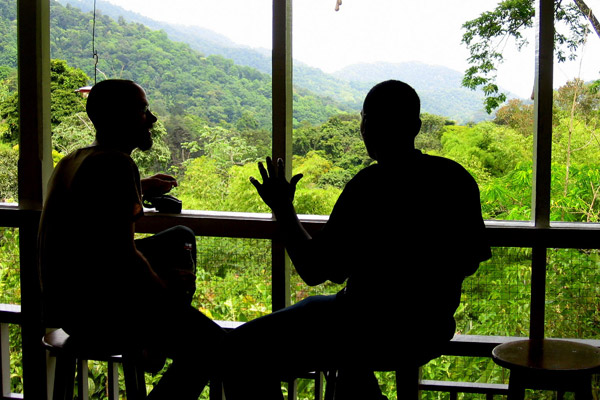
Nigel Noriega: SII’s aim is to influence the culture in tropical forest regions so that ecological sustainability can become the major economic driver of areas whose greatest assets have always rested in biodiversity. So our primary work is education, to help people connect concepts. At this stage, this means we make educational media and facilitate researchers working on the ground in Trinidad. These two activities give us the tools to transmit information between groups.
The role we have right now is to make scientific data more accessible to multiple interests who influence the heritage of tropical forest regions. We are working on media pieces for scientists and groups like grassroots reforestation projects, ecologically sustainable communities, and a major birding site and tourist attraction. We are also working on an exciting partnership with an ecology group called Trinibats, for an upcoming exposé that demystifies and explains the biology of bats (key players components of rainforest ecology). We aim to help each group communicate its own message.
We expect that shared information will help grassroots ecology and conservation movements pair with scientists, tour operators, agriculture, and industry. We are trying to be a hub that helps the information network linking sciences of ecology and economics integrate more smoothly. Tropical forest regions are at a tipping point where citizens can now process large amounts of information. We want to disseminate quality information and create a public that is highly educated regarding the value of existing land and seascapes.
We are barely over a year old, and our starting point is Trinidad. Our base projects are our documentary series and a field station that makes facilities affordable for students and scientists conducting longer-term studies. We are helping universities design field courses and working on media that helps scientists, naturalists and people working in ecological sustainability to get their message out to the public.
This article was written for Mongabay.com and re-posted on Focusing on Wildlife.

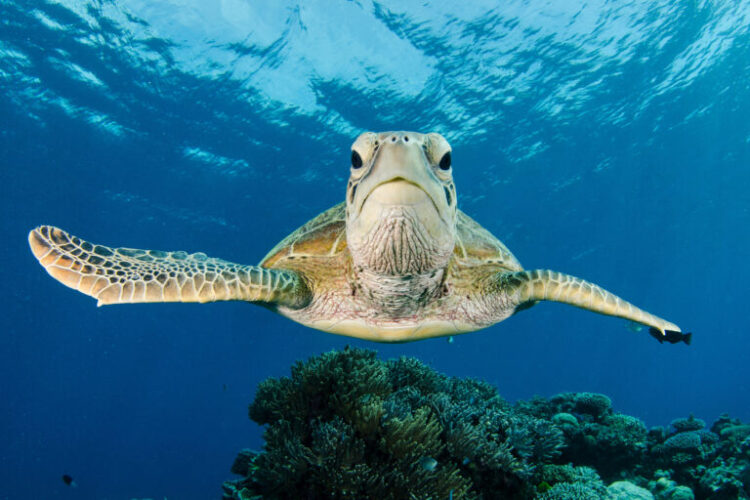
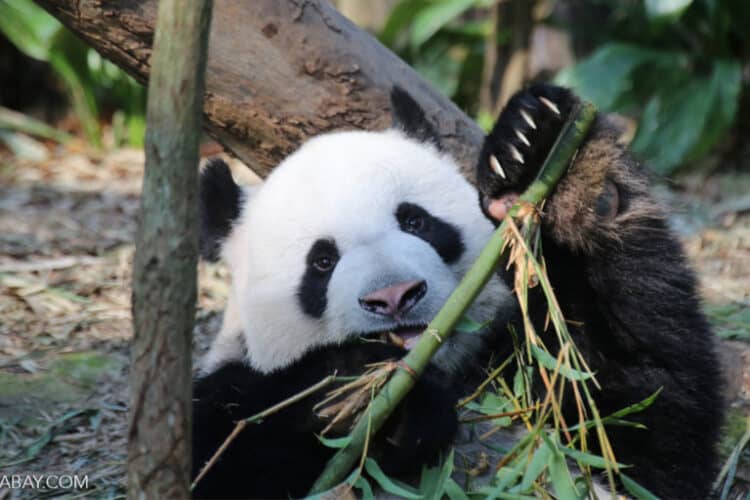
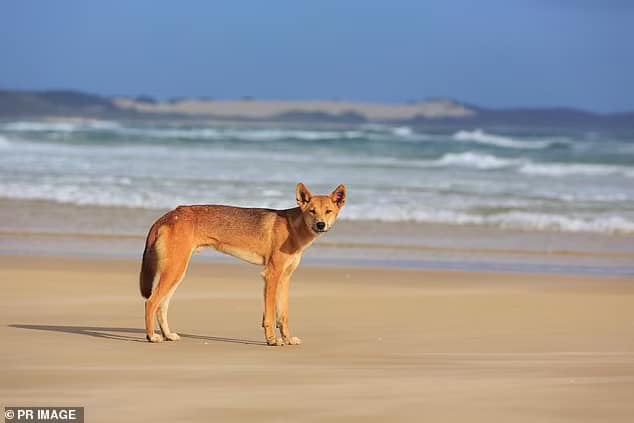

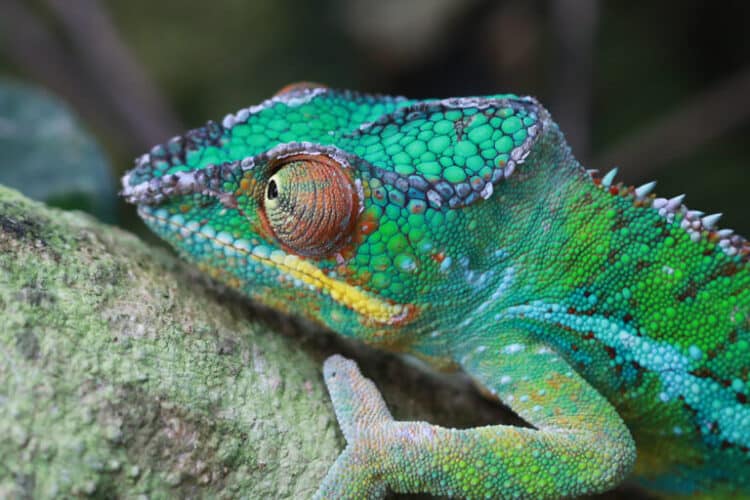
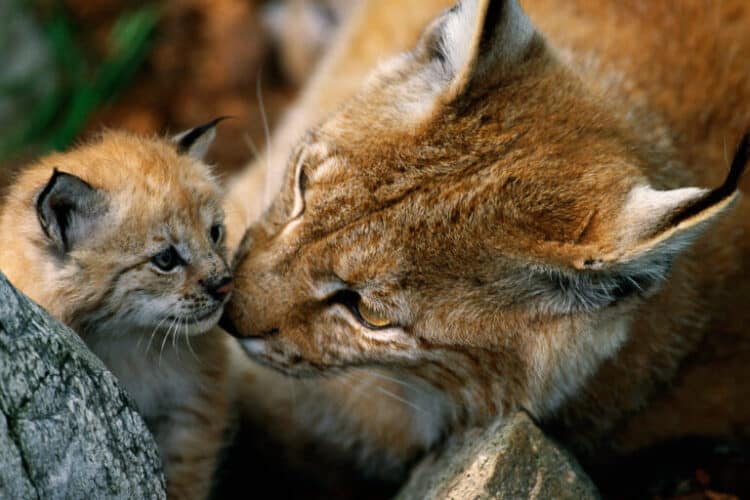
Leave a Reply